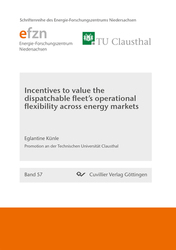| Areas | |
|---|---|
| Serie de libros (96) |
1378
|
| Nachhaltigkeit |
3
|
| Gesundheitswesen |
1
|
| Letra |
2363
|
| Ciencias Naturales |
5406
|
| Ciencias Ingeniería |
1791
|
| Ingeniería | 292 |
| Ingeniería mecánica y de proceso | 861 |
| Ingeniería eléctrica | 686 |
| Mineria y metalurgía | 30 |
| Arquitectura e ingeniería civil | 75 |
| General |
98
|
|
Leitlinien Unfallchirurgie
5. Auflage bestellen |
|
Erweiterte Suche
Incentives to value the dispatchable fleet’s operational flexibility across energy markets (Volumen 57) (Tienda española)
Eglantine Künle (Autor)Previo
Indice, PDF (550 KB)
Lectura de prueba, PDF (610 KB)
The work at hand participates with the energy transition toward decarbonized electricity production by providing a method to analyze the incentives for the dispatchable fleet to provide flexibility. It analyzes the signals set by the energy markets to investors and power plant operators regarding flexible power plant operation and the future requirement of thermal plant flexibilisation, with improvement suggestions. A method for the quantitative, long-term, high-resolution techno-economic assessment of an individual power plant’s operational flexibility is proposed. It includes the single unit self-scheduling problem of a merchant power plant solved from a price-taker perspective in the day-ahead, intraday and frequency control markets, as well as a parametric power plant model suited for operational flexibility assessments. The retroactive observation of the merchant power plants’ operation strategies in these markets is used to identify best practices in terms of market design for flexibility incentives. The value of operational flexibility improvements is quantified using various metrics, for different technologies and market environments. Despite their sensitivity to market design, technologies and cost structures, these results indicate that if investors further expect a three to five-year return on investment, the existing European conventional fleet is unlikely to experience a significant flexibilization.
| ISBN-13 (Impresion) | 9783736998902 |
| ISBN-13 (E-Book) | 9783736988903 |
| Formato | A5 |
| Idioma | Inglés |
| Numero de paginas | 208 |
| Edicion | 1. |
| Serie | Schriftenreihe des Energie-Forschungszentrums Niedersachsen (EFZN) |
| Volumen | 57 |
| Lugar de publicacion | Göttingen |
| Lugar de la disertacion | Clausthal |
| Fecha de publicacion | 07.11.2018 |
| Clasificacion simple | Tesis doctoral |
| Area |
Ingeniería de energía
|
| Palabras claves | Operational flexibility value quantification, European and liberalized electricity markets, spot markets, frequency control markets, conventional power plant flexibility, self-dispatch, unit commitment, power plant dispatch optimization |
| URL para pagina web externa | https://www.efzn.de/de/ueber-uns/oeffentlichkeitsarbeit/efzn-schriftenreihe/ |








